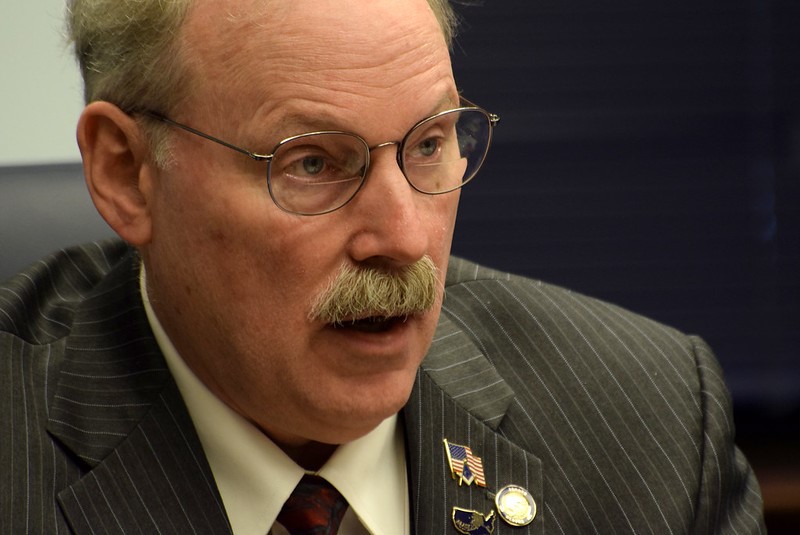
A consensus is emerging among the group tasked with reforming the Alaska Marine Highway System: The $24 million subsidy proposed Gov. Mike Dunleavy is insufficient, regardless of whether the ferries are a public or private entity. The nine-member task force appointed by the governor in February is facing a deadline later this fall.
The Alaska Marine Highway Reshaping Work Group as it’s called is chaired by Tom Barrett, a former Coast Guard admiral with logistical experience working for Alyeska Pipeline Service Company.
Members have been poring over data from a $250,000 study commissioned by the Dunleavy administration that concluded privatization of core services isn’t a realistic option.
“None of the dozens of studies have come up with the idea that any private operator could run the system and make a profit,” Barrett said at the group’s Thursday (7-16-20) meeting.
That study laid out scenarios for running the state’s ferry system on a $24 million subsidy, the amount Gov. Dunleavy had originally proposed shortly after taking office.
Wanetta Ayers’s day job is to run a public policy think tank in Anchorage. She says that low target was counterproductive.
“If we drive the system down to a $24 million subsidy, not only are we critically injuring the system, but we’re probably just stepping over dollars to pick up dimes because it’s going to cost us so much more as a state to try and sustain these communities that we’re crippling,” she said.
As the working group tries to identify what a minimal level of service would be, Ayers says she hopes they’ll remember the food shortages and other struggles some coastal communities faced last winter when the sole mainline ferry broke down.
Sen. Bert Stedman (R-Sitka) said the question of food security isn’t limited to just coastal villages in Alaska. The ferries are part of the state’s emergency supply chain in case of a catastrophe were to hit Rail Belt communities.
“We’ve been told by the finance committee that it’s probably unlikely that they’re going to be able to fly in enough food to take care of the population base,” Stedman said. “The marine highway becomes an essential corridor for keeping those Alaska citizens fed and watered.”

Sen. Bert Stedman (R-Sitka) is one of two legislators on the nine-person AMHS working group. (KCAW photo).
There’s at least one vocal ferry skeptic in the group. Tony Johansen, a Fairbanks-based highways contractor appointed to represent road-connected communities, has been critical of the Alaska Marine Highway System’s expense. He urged the working group to take a look at the size of populations served in relation to the amount of money required to provide ferry service.
“And consequently, I think there are some people that should not be served by the system,” Johansen said. “But I would think one of those groups of people is, where we’re spending a quarter billion dollars to build a boat to service Southwest Alaska.”
He’s referring to the long-stalled project to replace the aging ferry Tustumena which runs from Homer to Unalaska in the Aleutians. His remark opened up a classic dispute between Rail Belt vs. coastal Alaska communities.
“It’s frustrating to me to hear well, ‘We can’t do that just to serve 14,000 people,'” Rep. Louise Stutes (R-Kodiak), an outspoken critic of the governor’s cost-cutting. “Well, I’m going to tell you something, though. The road from Anchorage to Fairbanks wasn’t cheap. And it sure as hell isn’t cheap to maintain it and do all the work that DOT does on it.”
Members agreed that money alone wouldn’t fix the ferry system’s woes. Many of its problems stem from waste, mismanagement and poor planning.
Politicians on the call took aim at past political meddling in key decisions over design of the fleet’s ships.
“Every governor has a different idea,” Stedman said. “And sometimes back to back governors are, you know, 180 degrees out.”
That offered an opening for Robert Venables, chair of the Marine Transportation Advisory Committee. He’s been a proponent of a reform effort to make the marine highway a public corporation with more autonomy rather than an arm of the state’s Department of Transportation.
“I think the way you you get consistency among governors is if you take that decision away from the governor’s office,” Venables said. “And you put that decision for the design of these vessels into the hands of naval architects and marine engineers.”
He says the two Alaska Class Ferries – built at a cost of around $120 million – have yet to deliver. The only one that’s been launched — the Tazlina — is tied up and won’t be returned to service until it has new side doors installed.
Its range limitations are because it’s configured as a day boat. Without quarters for crew the ship can’t run for more than 14 hours in a stretch, limiting its abilities to serve many routes in the system. Its sister ship Hubbard has yet to ferry a single passenger and likely won’t be until new side doors are installed, DOT officials said.
“It’s mind boggling to me that the Hubbard took three, four years to build and then the state’s owned it for two years,” Venables continued. “There’s no plans for revenue service and it’s a brand new boat.”
The working group is tasked with defining what essential levels of service are for coastal communities without road access, how to make the fleet more efficient, and perhaps recommendations to change the way the ferry system is run. Its report is due by September 30.































